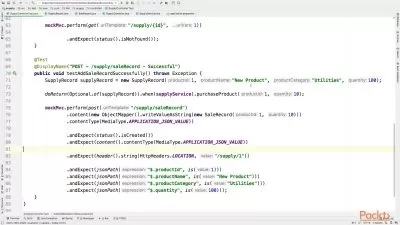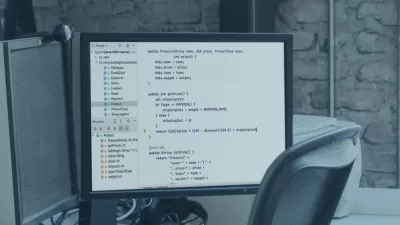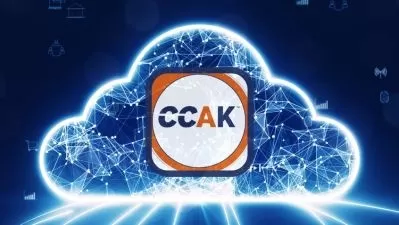Amazon Web Services (AWS) for Java Developers
Parwiz Forogh
13:36:36
Description
Master AWS Cloud Solutions with Java: A Comprehensive Guide for Java Developers
What You'll Learn?
- Create and manage AWS IAM users, roles, and policies programmatically using Java.
- Implement secure authentication and authorization mechanisms in Java applications for seamless access to AWS services.
- Learn to leverage AWS CloudShell as a convenient development environment for Java projects within the AWS ecosystem.
- Develop Java applications that interact with Amazon DynamoDB for efficient NoSQL data storage and retrieval.
- Optimize DynamoDB queries and performance within Java applications.
- Utilize Java SDK to perform operations on Amazon S3 buckets and objects, such as uploading, downloading, and managing files.
- Create, connect to, and manage Amazon RDS databases from Java applications.
- Provision, configure, and manage Amazon EC2 instances programmatically with Java.
- Deploy Spring-based Java applications on Amazon EC2 instances and configure them for production use.
- Develop serverless Java functions using AWS Lambda, allowing for efficient and cost-effective event-driven processing.
- Create, manage, and version AWS infrastructure as code (IaC) templates using AWS CloudFormation and Java.
- Configure and send email notifications from Java applications using Amazon Simple Email Service (SES).
- Deploy Spring-based Java applications to AWS Elastic Beanstalk for easy scaling and management.
Who is this for?
What You Need to Know?
More details
DescriptionAre you a Java developer looking to harness the power of Amazon Web Services (AWS) to enhance your applications, improve scalability, and enable seamless cloud integration? Look no further. This comprehensive course is designed specifically for Java developers like you, eager to unlock the full potential of AWS and revolutionize your cloud-based development skills.
What You'll Learn:
This hands on course will empower you with the knowledge and practical skills needed to excel in the world of AWS, guiding you through a step-by-step journey in mastering the integration of AWS services with Java applications. Here's what you can expect to achieve:
AWS IAM with Java: Understand the core concepts of AWS Identity and Access Management and implement secure access control within your Java applications.
AWS CloudShell: Explore the convenient AWS CloudShell environment and leverage it for efficient Java development within the AWS ecosystem.
AWS DynamoDB: Learn to develop Java applications that seamlessly interact with Amazon DynamoDB, optimizing data storage and retrieval.
Amazon S3: Master the Java SDK for Amazon S3 to perform file operations, securely store data, and enhance your application's capabilities.
Amazon RDS: Create and manage Amazon RDS databases from your Java applications, ensuring efficient data persistence.
Amazon EC2: Dive deep into Amazon Elastic Compute Cloud (EC2) and discover how to provision, configure, and manage instances programmatically using Java.
Deploy Spring Application to EC2: Deploy Spring-based Java applications on EC2, enabling you to scale and manage your applications effectively.
AWS Lambda: Develop serverless Java functions using AWS Lambda, transforming your application architecture for cost-effective event-driven processing.
AWS CloudFormation: Explore Infrastructure as Code (IaC) with AWS CloudFormation and automate AWS resource management using Java scripts.
Amazon SES: Configure and send email notifications from your Java applications using Amazon Simple Email Service (SES).
Deploy Spring Application to Elastic Beanstalk: Master the deployment of Spring-based Java applications on Elastic Beanstalk for scalability and easy management.
Why Choose This Course?
This course offers more than just theoretical knowledge; it provides practical, real-world examples that will empower you to implement what you've learned immediately. By the end of this course, you'll be equipped with the skills needed to confidently develop, deploy, and manage Java applications on AWS.
Prepare to unlock a world of possibilities with AWS and elevate your Java development career. Enroll now, and let's embark on this AWS journey together!
Who this course is for:
- Java Developers who are interested to work with AWS Services and Java
Are you a Java developer looking to harness the power of Amazon Web Services (AWS) to enhance your applications, improve scalability, and enable seamless cloud integration? Look no further. This comprehensive course is designed specifically for Java developers like you, eager to unlock the full potential of AWS and revolutionize your cloud-based development skills.
What You'll Learn:
This hands on course will empower you with the knowledge and practical skills needed to excel in the world of AWS, guiding you through a step-by-step journey in mastering the integration of AWS services with Java applications. Here's what you can expect to achieve:
AWS IAM with Java: Understand the core concepts of AWS Identity and Access Management and implement secure access control within your Java applications.
AWS CloudShell: Explore the convenient AWS CloudShell environment and leverage it for efficient Java development within the AWS ecosystem.
AWS DynamoDB: Learn to develop Java applications that seamlessly interact with Amazon DynamoDB, optimizing data storage and retrieval.
Amazon S3: Master the Java SDK for Amazon S3 to perform file operations, securely store data, and enhance your application's capabilities.
Amazon RDS: Create and manage Amazon RDS databases from your Java applications, ensuring efficient data persistence.
Amazon EC2: Dive deep into Amazon Elastic Compute Cloud (EC2) and discover how to provision, configure, and manage instances programmatically using Java.
Deploy Spring Application to EC2: Deploy Spring-based Java applications on EC2, enabling you to scale and manage your applications effectively.
AWS Lambda: Develop serverless Java functions using AWS Lambda, transforming your application architecture for cost-effective event-driven processing.
AWS CloudFormation: Explore Infrastructure as Code (IaC) with AWS CloudFormation and automate AWS resource management using Java scripts.
Amazon SES: Configure and send email notifications from your Java applications using Amazon Simple Email Service (SES).
Deploy Spring Application to Elastic Beanstalk: Master the deployment of Spring-based Java applications on Elastic Beanstalk for scalability and easy management.
Why Choose This Course?
This course offers more than just theoretical knowledge; it provides practical, real-world examples that will empower you to implement what you've learned immediately. By the end of this course, you'll be equipped with the skills needed to confidently develop, deploy, and manage Java applications on AWS.
Prepare to unlock a world of possibilities with AWS and elevate your Java development career. Enroll now, and let's embark on this AWS journey together!
Who this course is for:
- Java Developers who are interested to work with AWS Services and Java
User Reviews
Rating
Parwiz Forogh
Instructor's Courses
Udemy
View courses Udemy- language english
- Training sessions 153
- duration 13:36:36
- Release Date 2023/11/13
















